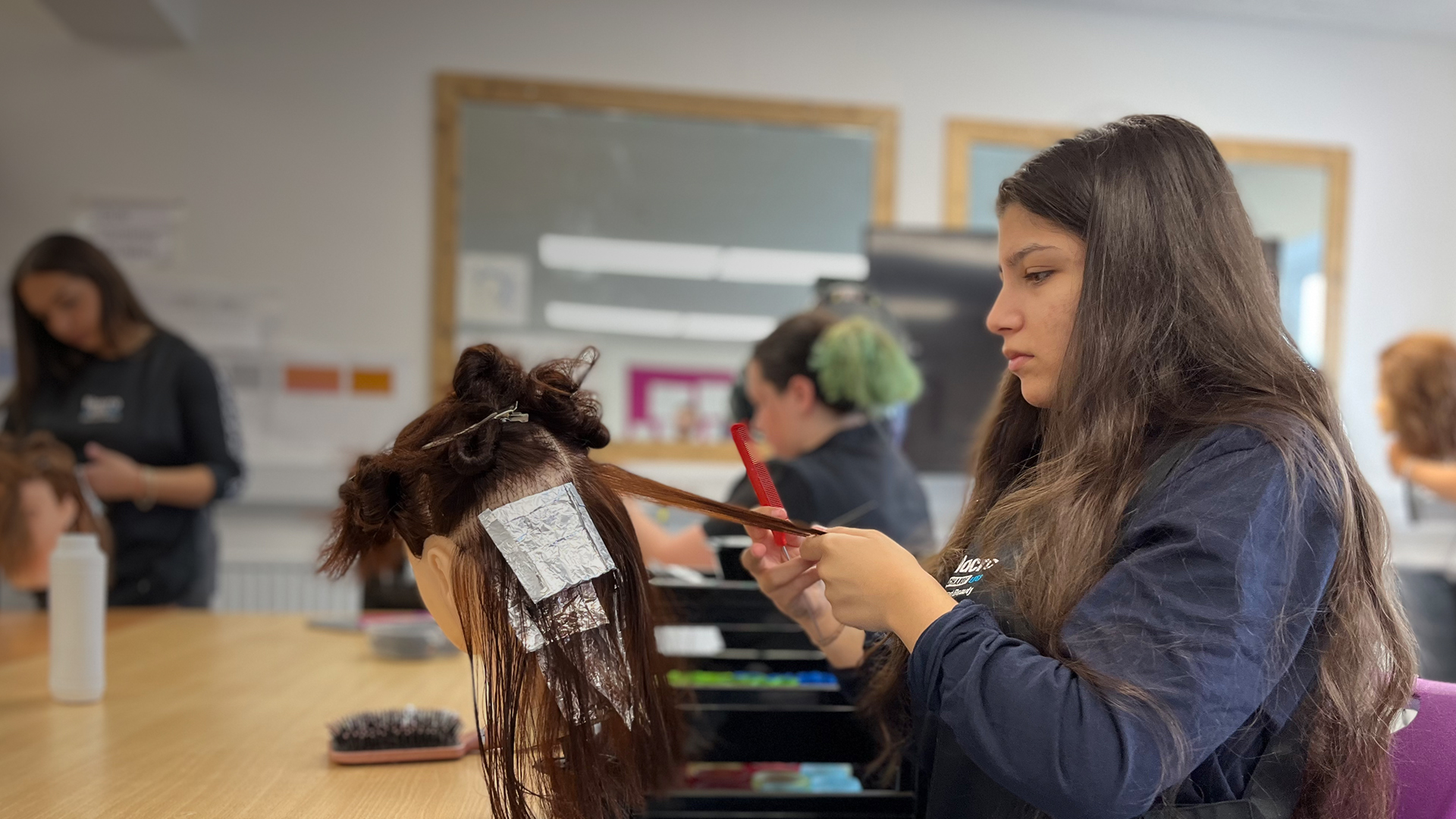
Safeguarding
Nacro’s safeguarding commitment
The safety and wellbeing of our service users, learners, and residents, is central to the services we provide.
At Nacro we are committed to ensuring that service users, learners, residents, and anyone who accesses our services are free from abuse, harm, and neglect. We are also committed to protecting their health, wellbeing, and human rights.
Safeguarding is the responsibility of all Nacro employees, volunteers, and contractors, whatever their role.
Governance
Our safeguarding commitment is supported by a strong governance structure, with clearly defined roles and responsibilities. This includes a Safeguarding Board, designated safeguarding officers (DSOs), and safeguarding leads in each service.
Our safeguarding policies and procedures are communicated to Trustees, staff, volunteers, and contractors. They are quality assured as part of our annual review process.
Our nationally recognised best practice on safer recruitment policy includes detailed pre-employment screening and enhanced DBS checks. This means we recruit staff with the right values, skills, and experience.
Nacro’s Safeguarding Policy and Procedures
Our safeguarding policy and procedures, covering the protection of adults and child protection, is communicated to all our learners, residents, and other service users.
The policy and procedures cover a range of issues including:
- bullying
- domestic violence
- teenage relationship abuse
- female genital mutilation
- child-on-child abuse
- sexual violence and harassment
- child sexual exploitation
- radicalisation
- trafficking, exploitation, and modern slavery
- forced marriage, so-called ‘honour’-based violence/killings
- gang violence and gang grooming
- online safety (including internet grooming and cyber bullying).
Prevent Policy – preventing violent and non-violent extremism and radicalisation
We also have a Prevent Policy as part of our duty to safeguard those using our services.
The policy identifies that directors and operational leads are responsible for implementing individual prevention action plans for each area.
Download the Prevent Policy [PDF].
Keeping children safe in education
Nacro adheres to the Department for Education’s latest statutory guidance for schools and colleges Keeping children safe in education. It covers staff guidance, the management of safeguarding, safer recruitment, allegations of abuse against staff and child-on-child sexual violence and harassment.
Safeguarding Policy Statement
The purpose and scope of this policy statement
Nacro believes that everyone deserves a good education, a safe and secure place to live, the right to be heard, and the chance to start again, with support from someone on their side.
We provide practical help and personalised support through our education, housing, justice and health and wellbeing services. We work closely with people to help them build independence and to move forward to a better future.
Nacro understands its responsibilities to identify and respond to suspected, and actual, individual cases of abuse or neglect.
The purpose of this policy statement is:
- to protect adults, children and young people from abuse or neglect. This includes the children of adults who use our services.
- to provide staff and volunteers, as well as service users, learners and their families, with the overarching principles that guide our approach to safeguarding and child protection.
This policy applies to anyone working on behalf of Nacro, including senior managers and the Board of Trustees, paid staff, volunteers, sessional workers, agency staff, visitors (including contractors) to defined locations and service users and learners. Separate procedures that relate to specific adult safeguarding and specific children safeguarding practice support this overarching policy statement. These procedures are referenced below.
- Young people safeguarding procedures.
- Adults safeguarding procedures.
- Safeguarding risk assessment procedures.
- Safeguarding incident report procedures.
A list of specific Nacro polices that relate to our safeguarding work are shown in Appendix 1.
We believe that:
- Adults, children, and young people should not experience abuse of any kind.
- We have a responsibility to promote the welfare of all vulnerable adults, children, and young people, to keep them safe and to deliver our services in a way that protects them.
We recognise that:
- The welfare of children and vulnerable adults is paramount in all the work we do and in all the decisions we take.
- Working in partnership with children, young people, their parents, carers, and statutory agencies is essential in promoting the welfare of young people and vulnerable adults.
- All children and vulnerable adults, regardless of age, disability, gender reassignment, race, religion or belief, sex, or sexual orientation have an equal right to protection from all types of harm or abuse.
- Some people are additionally vulnerable because of the impact of previous experiences, their level of dependency, communication needs or other issues.
- Extra safeguards may be needed to keep children who are additionally vulnerable safe from abuse, for example children who come from minority ethnic communities, safeguarding deaf and disabled children and young people, safeguarding LGBTQ+ children and young people, safeguarding children with special educational needs and disabilities (SEND).
We keep people safe by:
- Adopting child protection and safeguarding best practice through our policies, procedures, and code of conduct for staff and volunteers
- Promoting an anti-bullying environment.
- Making sure that staff, volunteers, vulnerable adults, children, young people and their families or carers know where to go for help if they have a concern.
- Seeking feedback from stakeholders about our safeguarding practice.
- Recruiting and selecting staff and volunteers safely, ensuring all necessary checks are made before colleagues start.
- Developing and implementing online safety protocols.
- Embedding dedicated roles for safeguarding at each service location, within each directorate and within the senior leadership structures of the charity.
- Using the Nacro National Safeguarding Board (NSB) to sponsor the embedding of safeguarding practice across the charity through a cycle of continuous improvement.
- Providing effective management for staff and volunteers through supervision, support, and training to enable colleagues to understand our behaviour codes confidently and competently.
- Celebrating Safeguarding Week annually to raise awareness of our responsibilities.
- Embedding safeguarding and prevent topics within our education curriculum design.
- Using risk assessments and support planning tools to encourage learners and service users to identify how to keep themselves safe and well.
- Having up to date information recording and information sharing protocols that are in line with data protection legislation and formal procedures.
- Embedding clear complaints and whistleblowing procedures.
- Establishing safe physical environments for the children, young people, vulnerable adults, staff, and volunteers in our services, by applying health and safety measures in accordance with the law and regulatory guidance
Responsibilities
We have clearly defined safeguarding expectations and responsibilities for specific staff groups and individuals. These are:
- All colleagues.
- Managers.
- Designated Safeguarding Officers (DSO).
- Area Designated Safeguarding Officers (ADSO) – education service only.
- Directorate Safeguarding Leads (DSL).
- Trustees.
- The information communications technology (ICT) team.
- The human resources (HR) and organisational development (OD) team.
Details of the expectations of each role is set out in Appendix 2.
Our approach to monitoring
All safeguarding incidents are reviewed by DSLs. All serious incidents are reported to NSB and the Strategy and Performance Committee on a regular (usually quarterly) basis.
Our approach to training
A comprehensive set of safeguarding training materials are available via Nacro’s Learning Management System. All colleagues are required to complete mandatory safeguarding courses that are aligned to their working role. Additional training is provided to DSOs. Regular reports on training completeness are provided to NSB.
Key reference documents used to develop our safeguarding practice
This policy has been drawn up based on legislation, policy and guidance that seeks to protect adults and children in England and Wales. The prime reference documents for the policy include:
- The Children Act 2004.
- Working together to safeguard children 2018.
- The latest version of the Keeping Children Safe in Education’ (KCSIE) statutory guidance.
- The Care Act 2014.
- The Care and Support Statutory Guidance 2017.
- The Mental Capacity Act 2005.
The NSB will track legalisation changes that apply to safeguarding. The NSB will then action adjustments to Nacro’s policies and procedures as appropriate.
Our approach to data protection
We understand successful safeguarding requires a collaborative approach and that sharing information about safeguarding concerns is essential. We work within statutory guidance, set out by the Department of Education for example, to manage data and information.
We will seek the learner’s or service user’s permission to share their information. However, we understand General Data Protection Regulation (GDPR) is not a barrier to sharing safeguarding information with responsible agencies. Sharing information without consent may be justified, if, for example:
- other people are, or may be, at risk, including children
- sharing the information could prevent a crime
- a serious crime has been committed
- the person has the mental capacity to make that decision, but they may be under duress or being coerced
- the risk is unreasonably high and meets the criteria for a multi-agency risk assessment conference referral
- a court order or other legal authority has requested the information.
If the decision is made to share information with external partners without consent, the learner or service user will be informed. Any risk to the person in doing so will be considered and advice may be sought from the local authority or police without disclosing any personal details.
Appendix 1
Specific policies that relate to our safeguarding procedures:
- dealing with disclosures and concerns about a child or young person
- managing allegations against staff and volunteers
- code of conduct for staff and volunteers
- behaviour codes for children and young people
- photography and sharing images guidance
- safer recruitment
- managing complaints
- whistleblowing
- health and safety (incident reporting)
- ICT and web use policies, including keeping people safe online.
Appendix 2
Specific responsibilities for key roles in safeguarding
All colleagues:
- Empower service users/learners to have open conversations about safeguarding, equalities, and radicalisation, while challenging unacceptable views/attitudes/behaviours.
- Be alert to indicators of abuse or neglect.
- Promote safeguarding conversations in services (e.g., displaying posters).
- Work with service users/learners to prevent or minimise circumstances which can lead to abuse, including isolation, unhealthy relationships, or restricting access to financial services.
- Respond to any risks you perceive or are informed about by using Nacro’s Risk Assessment Policy.
- Continue to monitor the learner or service user that you have shared concerns about or who has disclosed a safeguarding issue to you.
- Undertake safeguarding training as directed by your manager or the DSO.
- Report safeguarding concerns on Nacro’s incident management system.
- Escalate concerns or clarifications to the DSOs and/or make appropriate safeguarding referrals to the relevant authority should you become aware of a safeguarding concern.
- Undergo checks by the Disclosure and Barring Service (DBS).
All managers:
- Ensure safeguarding policy and procedures are implemented and reporting structures are adhered to.
- Ensure all colleagues have an appropriate level of knowledge of safeguarding relevant to their role.
- In relevant settings ensure safeguarding is a standing item on team meeting agendas and discussed during supervision and case reviews.
- Work with DSOs or DSLs to enable good local good working arrangements with local authority safeguarding teams and prevent teams are maintained.
- Be familiar with local safeguarding appeals processes and internal Nacro escalation process.
- Ensure all reporting and recording of safeguarding concerns is accurate, timely, client centred, and recorded appropriately.
Designated Safeguarding Officer (DSO):
- Make sure the staff understand the correct safeguarding procedures to follow.
- DBS requirements are in date and where appropriate proper risk assessments are undertaken.
- Make sure that staff are aware of the relevant Safeguarding Adult Board contact details; contact details for the DSL and area DSO.
- Provide advice and guidance to staff on dealing with individual cases and concerns
- Support staff to make referrals to appropriate agencies with regards to concerns about safeguarding, including radicalisation, as required.
- Overseeing referrals to adult social care, and channel in the case of radicalisation; this includes following up cases with children or adult social care to ensure that appropriate action has been taken.
- Completion of Local Authority Designated Officer (LADO) referrals, where appropriate.
- Attend, and contribute to, conferences/meetings, multi-agency meetings called to review the care or safeguarding issues of any adult/children.
- Be aware of the additional issues for adults with learning difficulties and/or disabilities and ensure staff are aware of these.
- If partner agencies are not following up on concerns, enable the matter to be escalated.
- Work with managers to ensure new staff receive training on safeguarding as soon as possible following their appointment.
- Check/monitor from time-to-time staff knowledge and understanding of safeguarding.
- Maintaining an overview of how effectively safeguarding is being managed within the services in their area.
- Providing feedback and information to DSLs and senior leaders about safeguarding issues, concerns, incidents, and their management.
- Undertake safeguarding training as directed the management team or DSL.
Area Directorate Safeguarding Officers (ADSO):
- Maintaining an overview of how effectively safeguarding is being managed within the designated area.
- Providing support and guidance to DSOs in managing safeguarding concerns and incidents.
- Providing feedback and information to DSLs and senior leaders about safeguarding issues, concerns, incidents, and their management.
- Undertake safeguarding training as directed the DSL.
- Within education, ADSOs are required to make introductory calls to all new starters (employees) within two weeks of their start date as part of their induction to ensure they are aware of the relevant safeguarding policies, procedures, and safeguarding structure. This is followed up by an email to provide key policies and resources.
Directorate Safeguarding Leads (DSL):
- Work with the NSB to review and develop safeguarding procedures that are fit for purpose and relevant.
- Work with the NSB to cascade updates to existing policy and procedures.
- Review safeguarding incident reports and provide advice and guidance to staff on dealing with individual cases and concerns.
- Overseeing all the serious incidents and ensure that incident management reports (IMR)/fact findings are conducted to identify learnings and best practices.
- When required, attend, and contribute to, conferences/meetings, multi-agency meetings called to review the care or safeguarding issues of any adult/children.
- If partner agencies are not following up on concerns where they need to, to make sure the matter is escalated as detailed in our safeguarding procedures.
- Ensure open cases on the incident management system (IMS) are reviewed and closed in a timely manner.
- Provide guidance and continue support to area DSOs when there are concerns before, during and after an incident.
- Provide reports to NSB meetings to enable assurance of safeguarding activity to be tested and reviewed.
- Review all incidents of safeguarding concerns that are report via IMS2 or via other routes that have been established.
- Via DSOs ensure colleagues understand the correct safeguarding procedures to follow.
- Via DSOs ensure colleagues have access to the relevant Safeguarding Adult Board contact details and relevant internal contacts.
- Via DSOs ensure colleagues are aware of specific additional considerations that need to be acknowledged for people with learning difficulties and/or disabilities.
- Work with the NSB to develop training and briefings on safeguarding issues, risk management and revisions to current procedures.
- Provide support and coaching DSOs regarding LADO referrals.
Trustees:
- Lead a whole organisation approach to safeguarding. Ensure that safeguarding and child protection are ‘at the forefront’ and underpin all relevant aspects of process and policy development.
- Via the NSB seek assurance that everybody working with vulnerable people understands their safeguarding responsibilities.
- Work with the senior leadership team to appoint a DSL who ensures all colleagues responsible for leading safeguarding practice understand their role and responsibilities. In particular, Trustees must have assurance that children are taught about safeguarding, including online safety and, where necessary, that teaching is adapted for those with specific needs and vulnerabilities, including victims of abuse and some pupils with special educational needs (SEN) and/or disabilities.
- Ensure they receive appropriate safeguarding and child protection (including online) training at induction.
- Must be aware of their obligations under the Human Rights Act 1998, the Equality Act 2010 and the Public Sector Equality Duty (PSED).
- Embed a culture of openness and create environment where everyone feels supported to use safeguarding concerns they have.
- Support the use of the whistleblowing policy and promote the policy’s existence.
ICT team:
- Develop and maintain an ICT environment that confirms to agreed safeguarding and prevent security controls, where the controls required are specified by the NSB.
- Provide ad hoc reports on the access and use of ICT equipment and systems as required.
HR and OD team:
- Develop and maintain agreed training and development materials that support safeguarding and prevent policies.
- Provide reports on training up take.
Our safeguarding executive team

Andrew Hodges
Executive Lead with Safeguarding Responsibility



Andrew Hodges
Executive Lead with Safeguarding Responsibility
As our Health and Safety lead, Andrew Hodges’ responsibility includes:
- Monitoring Nacro’s compliance with health and safety requirements
- Assessing the risks of failure to comply with health and safety requirements;
- Notifying the Regulator for Social Housing of:
- Any risks of material failures by Nacro to comply with health and safety requirements.
- Any material failures by Nacro to comply with health and safety requirements.
- Explain to the Regulator how Nacro will address risks and failures notified to them.
- Nacro is responsible for ensuring that our Health and Safety lead:
- Has sufficient authority within the organisation.
- Can devote sufficient time to the functions of the health and safety lead, to be able to perform the role of health and safety lead effectively; and
- Has the resources needed to carry out those functions.
- The health and safety lead is not:
- Responsible for the registered provider’s compliance with health and safety requirements, or
- Liable for a failure by the registered provider to comply with health and safety requirements,
Email: andrew.hodges@nacro.org.uk.



Gemma Goacher
Housing Directorate Safeguarding Lead






Clare Kirk
Educational Directorate Safeguarding Lead






Eliana Silva
Justice and Health Directorate Safeguarding Lead



Leaders, managers, and staff place a very high priority on safeguarding learners. Managers provide effective oversight of safeguarding arrangements. They use external scrutiny well to provide assurance on the effectiveness of safeguarding arrangements.Ofsted 2019 Report


Safeguarding Week
Nacro holds an annual Safeguarding Week to promote awareness, share good practice, and strengthen our safeguarding policies and practice. Employees and services across Nacro get involved by making pledges, organising events, meeting partner organisations, attending training, and engaging learners and service users.
Read our blog on children’s mental health from external expert to our National Safeguarding Board, Deanna Neilson.
Safeguarding will always be a challenge, but by continuing to adapt the way we work and listen to those who experience, or are at risk of harm, we can keep building a safer culture for everyone.Zoe, Nacro's Designated Safeguarding Officer


Video: How to have a wellbeing conversation
Advice for how you can talk to others about how they are feeling in an appropriate, caring and professional way. This video was produced as part of Wellbeing Week 2021.
